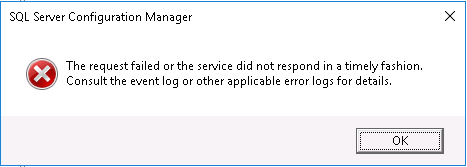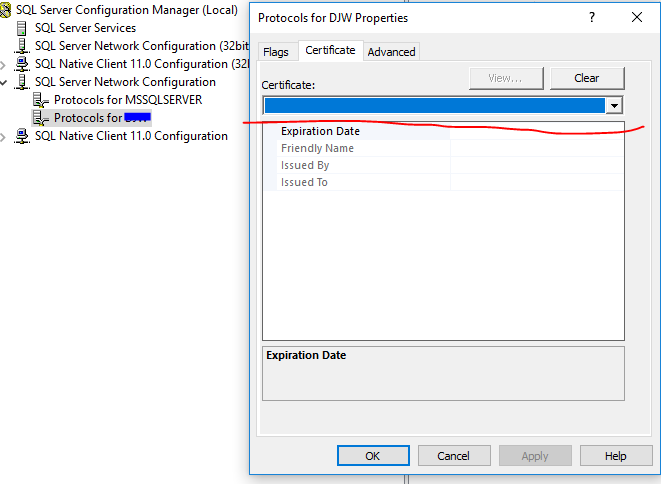Note
Access to this page requires authorization. You can try signing in or changing directories.
Access to this page requires authorization. You can try changing directories.
Monday, February 11, 2019 4:17 PM
When I tried to start the SQL Server (MSSQLSERVER) service in Sql Server Configuration Manager, I got this error.

Then I check the event viewer and I saw this error:
SQL Server (MSSQLSERVER) service terminated with the following service-specific error:
Cannot find object or property.
I also saw this error in the Event Viewer.
Log Name: Application
Source: MSSQLSERVER
Date: 2/11/2019 10:04:14 AM
Event ID: 17120
Task Category: Server
Level: Error
Keywords: Classic
User: N/A
Computer: DB03
Description:
SQL Server could not spawn FRunCommunicationsManager thread. Check the SQL Server error log and the operating system error log for information about possible related problems.
Log Name: Application
Source: MSSQLSERVER
Date: 2/11/2019 10:04:14 AM
Event ID: 17826
Task Category: Server
Level: Error
Keywords: Classic
User: N/A
Computer: DB03
Description:
Could not start the network library because of an internal error in the network library. To determine the cause, review the errors immediately preceding this one in the error log.
Log Name: Application
Source: MSSQLSERVER
Date: 2/11/2019 10:04:14 AM
Event ID: 17182
Task Category: Server
Level: Error
Keywords: Classic
User: N/A
Computer: DB03
Description:
TDSSNIClient initialization failed with error 0x80092004, status code 0x1. Reason: Initialization failed with an infrastructure error. Check for previous errors. Cannot find object or property.
Log Name: Application
Source: MSSQLSERVER
Date: 2/11/2019 10:04:14 AM
Event ID: 17182
Task Category: Server
Level: Error
Keywords: Classic
User: N/A
Computer: DB03
Description:
TDSSNIClient initialization failed with error 0x80092004, status code 0x80. Reason: Unable to initialize SSL support. Cannot find object or property.
Log Name: Application
Source: MSSQLSERVER
Date: 2/11/2019 10:04:14 AM
Event ID: 26014
Task Category: Server
Level: Error
Keywords: Classic
User: N/A
Computer: DB03
Description:
Unable to load user-specified certificate [Cert Hash(sha1) "B07835B122B24693C50DACFB320CEDB2BF9D1EBC"]. The server will not accept a connection. You should verify that the certificate is correctly installed. See "Configuring Certificate for Use by SSL" in Books Online.
Log Name: System
Source: Schannel
Date: 2/11/2019 10:04:14 AM
Event ID: 36870
Task Category: None
Level: Error
Keywords:
User: SYSTEM
Computer: DB03
Description:
A fatal error occurred when attempting to access the TLS server credential private key. The error code returned from the cryptographic module is 0x8009030D. The internal error state is 10001.
Log Name: System
Source: Microsoft-Windows-DistributedCOM
Date: 2/11/2019 10:04:13 AM
Event ID: 10016
Task Category: None
Level: Error
Keywords: Classic
User: NT SERVICE\MSSQLSERVER
Computer: DB03
Description:
The application-specific permission settings do not grant Local Activation permission for the COM Server application with CLSID
{D63B10C5-BB46-4990-A94F-E40B9D520160}
and APPID
{9CA88EE3-ACB7-47C8-AFC4-AB702511C276}
to the user NT SERVICE\MSSQLSERVER SID (S-1-5-80-3880718306-3832830129-1677859214-2598158968-1052248003) from address LocalHost (Using LRPC) running in the application container Unavailable SID (Unavailable). This security permission can be modified using the Component Services administrative tool.
Monday, February 11, 2019 4:24 PM
Looks like certificate error. May be it got removed
Try re-installing it as per
Please Mark This As Answer if it solved your issue
Please Vote This As Helpful if it helps to solve your issue
Visakh
My Wiki User Page
My MSDN Page
My Personal Blog
My Facebook Page
Tuesday, February 12, 2019 8:36 AM | 1 vote
Hi Charlie2,
As mentioned by Visakh, it is a certificate error. It may be that the certificate you specified has been removed. Sql server can not find the certificate you specified in the certificate store at startup, this problem will occur.
After my test, when I specified an incorrect certificate for the instance, I encountered the same error as you.
There are two ways to solve this problem:
1.Modify the certificate value in the registry(Computer\HKEY_LOCAL_MACHINE\SOFTWARE\Microsoft\Microsoft SQL Server\MSSQL14.INSTANCENAME\MSSQLServer) to be null. SQL Server will automatically search for the certificate that meets the requirements in the certificate store. The it will load and start.If a certificate that meets the requirements is not found, SQL Server automatically generates a self-signed certificate and installs it on the certificate.

2.Reconfigure the certificate in SSCM:

Best regards,
Dedmon Dai
MSDN Community Support
Please remember to click "Mark as Answer" the responses that resolved your issue, and to click "Unmark as Answer" if not. This can be beneficial to other community members reading this thread. If you have any compliments or complaints to MSDN Support, feel free to contact MSDNFSF@microsoft.com
Wednesday, February 13, 2019 2:39 PM
Thank you for all the help. I got it working now. The issue is that all the account agents that start the sql server services do not have read access in the certificate.
Thursday, February 14, 2019 7:24 AM
Hi Charlie2,
I'm glad to know that your problem has been solved and you shared the reason for the problem. In order to close this thread, please kindly mark helpful replies as answers. By doing so, it will benefit all community members who are having this similar issue. Your contribution is highly appreciated.
Best regards,
Dedmon Dai
MSDN Community Support
Please remember to click "Mark as Answer" the responses that resolved your issue, and to click "Unmark as Answer" if not. This can be beneficial to other community members reading this thread. If you have any compliments or complaints to MSDN Support, feel free to contact MSDNFSF@microsoft.com
Saturday, December 7, 2019 6:12 AM
"The issue is that all the account agents that start the sql server services do not have read access in the certificate."
I am facing same issue.
Can you please explain how you provided access.
Also which agentyou are talking in this scenario.
Please explain.
Regards,